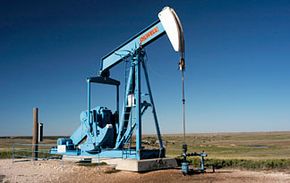Primaryoilrecovery is the first phase, which happens once a well has been drilled from the surface to an underground reserve. Gravity, along with the pressure inside the reservoir, forces the oil into the wellbore. The wellbore is another name for the hole that was drilled to extract the oil. From here, the oil is brought to the surface through mechanical means, like a pump jack. The primary phase of oil recovery continues until the pressure inside the well is no longer enough to produce oil in quantities that make it financially worthwhile.
Primary recovery is an important step in the process because the natural pressure inside the underground reservoir must be equalized before any equipment can be installed. While it’s necessary, it’s not all that effective -- this phase only produces about 10 percent of a reserve’s supply. According to the U.S. Department of Energy, there are 600 billion barrels of oil available within the 50 states. But if primary oil recovery methods were our only way to access these reserves, more than 400 billion barrels would be irretrievable.






